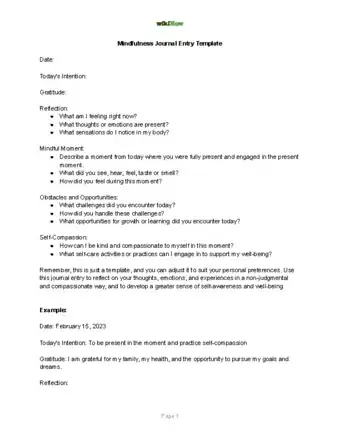This article was co-authored by Trudi Griffin, LPC, MS. Trudi Griffin is a Licensed Professional Counselor in Wisconsin specializing in Addictions and Mental Health. She provides therapy to people who struggle with addictions, mental health, and trauma in community health settings and private practice. She received her MS in Clinical Mental Health Counseling from Marquette University in 2011.
There are 13 references cited in this article, which can be found at the bottom of the page.
wikiHow marks an article as reader-approved once it receives enough positive feedback. In this case, 80% of readers who voted found the article helpful, earning it our reader-approved status.
This article has been viewed 235,026 times.
A person is mindful when they are aware of their surroundings, actions, and emotions. Being mindful is not simply being alert. Instead, it is paying attention very carefully to your environment. You can train yourself to be more mindful. Mindfulness can have a positive impact on both your personal and professional life.[1] There are many steps you can take to becoming more mindful.
Steps
Teaching Yourself to Be Mindful
-
1Train your mind. Mindfulness is the habit of consciously paying attention to what is going on around you. Being mindful takes practice. There are many ways that you can train your mind to increase your mindfulness every day.[2]
- Think about all of the things you do on a daily basis: you eat, you breathe, you move, you speak. These are just a few examples. Imagine if you begin to be more aware of each part of your day. Think about what you might notice if you begin to truly pay attention to the small parts of your life. This is your first step towards being more mindful.
-
2Practice being mindful during your routine activities. For example, pay attention to each step as you make your morning coffee. Then, be aware of how your senses react while drinking your coffee. Each day, try being mindful of a new part of your routine.
- Try being mindful during your morning shower. Actually think about your senses. Does the warm water feel good? Do you like how your shower gel smells? Pay attention to the sensations involved in each part of your daily routine.[3]
Advertisement -
3Be brief. Your mind actually works better in short bursts of activity, so keep your practice sessions short. Studies show that it is more productive and useful to break up lengthy stretches of concentration. You will actually be able to be more mindful if you keep your practice sessions short.[4]
- For example, focus on picking out an outfit for work, but then let your mind wander while you go through the motions of actually getting dressed.
Learning Mindful Habits
-
1Try meditation. Meditating can be very beneficial for your brain. Practicing meditation can help you more effortlessly be mindful, as it will become your brain's default setting. Learn about meditation, and find a training method that is right for you.
- Meditation is most effective when you formally train your mind how to practice it. Try finding a book or audio book that will guide you through a series of meditations. You can also take guided meditation courses offered by professionals.
- To get started, find a calm, quiet space to meditate. Close your eyes, and sit comfortably. Choose a word or phrase to focus on. You can say this out loud or inwardly. Popular choices are "ohm" and "love".[5]
-
2Improve your relationship. Your romantic relationship affects all aspects of your life. Research shows that couples who are more mindful are happier and more physically healthy. Ask your partner to join you in trying to become more mindful.[6]
- Try meditating with your partner. The simple act of engaging in mindfulness at the same time and the same place can help you bond. Another way to increase your mindfulness is to practice your communication skills with your partner. Focus on really hearing one another.
-
3Listen carefully. Truly hearing what someone else is saying is one of the best ways to be mindful. Often when you are conversing with someone else, your inner-voice is active while they are talking. Sometimes you are judging their words, or maybe half thinking about something else. Mindfulness is truly paying attention when someone else is talking.[7]
- If possible, have important conversations face to face. Make eye contact. This will help you bond with the person you are listening to, and help you absorb what they are saying.
-
4Monitor your health. Being aware of your physical health is an important part of being more mindful. Pay attention to your body, and be aware of energy levels, hunger pangs, and aches and pains. Tuning in to signals from your body will help with your overall well-being.[8]
- Practice mindful eating by consciously being aware of the foods you choose to eat. You should think not only about your likes and dislikes, but also consider nutritional value. Additionally, be aware of the act of eating and note how your senses (sights, smells, taste) respond to different foods.
Practicing Being Mindful
-
1Be aware of your feelings. Mindfulness in the work place is a great quality to cultivate. Being more mindful can make you more productive at work, and can also decrease your stress. One way to be more mindful is to check in with your emotions, and take note of how you feel when you're at work.
- Get in the habit of checking in with yourself. You may be stressed out during the day without even being aware of it. Be mindful, and pay attention to signs of tension. If you find your heart race increasing, or that your shoulders are tense, take a minute to remove yourself from the stressful situation and calm down.
-
2Focus on breathing. Being aware of your breath is very important to being more mindful. Taking deep, calming breaths can help you focus and can also help to lower your blood pressure. Before a big meeting, try taking some several deep breaths to gain your composure.[9]
- Try setting aside two three minute periods per day to practice your breathing. You can do this at your desk. Simply set aside your work for three minutes and allow yourself to concentrate fully on breathing.
-
3Take a break. Research shows that you are actually a more productive person when you allow yourself to take regular breaks. It is important to allow your brain to relax. Part of being mindful is realizing when you need to let your mind drift.[10]
- It is ideal to take one ten-minute break every hour. If you can't manage that, try taking several thirty-second mini-breaks. During these brief timeouts, let your mind drift and indulge in some daydreams.
-
4Use visualization. This technique can help you be a less stressed, more effective person. Try visualizing yourself doing something great. Perhaps you are delivering an outstanding presentation or cooking an amazing dinner for your family. Whatever you see, make sure you are visualizing your best self.[11]
-
5Use the right language. Pay attention to both your words and your body language. You want to communicate that you are present and connected to your co-workers, friends, and family. This will make you a more effective communicator, and increase your mindfulness.
- Watch the words that you use in workplace conversations. When you use words like being "swamped" you are telling yourself and your co-worker that you are experiencing a negative situation. Be mindful, and use positive language. Try saying that your schedule is "full" instead.
- Breathing is an important part of your body language. If your breathing is erratic, it signals to your body and others that you are under stress. This is not a positive image to project.
Understanding Mindfulness
-
1Learn about mindfulness. Try doing some reading about mindfulness. There is no set definition, so you'll want to get information from a few different sources. Remember, mindfulness is about being aware, but non-judgmental. Learning about the concept will help deepen your practice.
-
2Know the benefits. Practicing mindfulness can have positive impacts on both your mind and your body. People who are more mindful are shown to have lower blood pressure and reduced anxiety. It can also help to increase your memory and lessen symptoms of depression.[12]
-
3Change your habits. In order to become more mindful, it is likely that you will need to make some changes to your daily life. Try forming new habits to aid in your practice. Remember, new habits take about two months to truly take hold. Be patient with yourself.[13]
- Add a daily walk to your routine. Being outside is a great time to practice being mindful. Turn off your headphones and unplug while talking a stroll each day.
- Consciously add breaks to your day. Even when you're not at work, you need several time-outs throughout the day. Give yourself permission to do nothing for at least a few minutes at a time. Let your thoughts wander.
-
4Acknowledge your progress. Speak positively to yourself. When you have negative thoughts, acknowledge them and let them go. Focus on saying positive things in your inner dialogue. Note the good aspects of each situation. [14]
- When you feel frustrated by your progress, acknowledge how you feel. Then purposefully shift your attitude into congratulating yourself on the progress that you have made.
Mindfulness Journal Entry Template
Expert Q&A
-
QuestionHow do I become more mindful?
 Michael SternMichael Stern is a life coach and the owner of Integral Alignment, a coaching and training business focused on a holistic approach to optimizing one's health, work, love, play, and spirituality. Michael began his professional training in 2011 as an Integral Spiritual Mentor through One Spirit Learning Alliance, and has been certified as both a hatha yoga instructor and an Emotional Intelligence Coach through GolemanEI. In addition to his private 1:1 and groupwork, he has hosted workshops with thought leaders such as Frederic Laloux, Charles Eisenstein, and Thomas Hübl. Michael holds a BA in Spanish Language from Vanderbilt University and lives in Portland, Maine.
Michael SternMichael Stern is a life coach and the owner of Integral Alignment, a coaching and training business focused on a holistic approach to optimizing one's health, work, love, play, and spirituality. Michael began his professional training in 2011 as an Integral Spiritual Mentor through One Spirit Learning Alliance, and has been certified as both a hatha yoga instructor and an Emotional Intelligence Coach through GolemanEI. In addition to his private 1:1 and groupwork, he has hosted workshops with thought leaders such as Frederic Laloux, Charles Eisenstein, and Thomas Hübl. Michael holds a BA in Spanish Language from Vanderbilt University and lives in Portland, Maine.
Life Coach Schedule a short “recovery break” at the mid-morning and mid-afternoon points of the day to do a quick mindfulness exercise. You can also set an alarm on your phone to go off at regular intervals throughout the day (eg every hour) to remind you to check in on your breathing and what it feels like to be in your body.
Schedule a short “recovery break” at the mid-morning and mid-afternoon points of the day to do a quick mindfulness exercise. You can also set an alarm on your phone to go off at regular intervals throughout the day (eg every hour) to remind you to check in on your breathing and what it feels like to be in your body.
References
- ↑ https://www.apa.org/monitor/2012/07-08/ce-corner
- ↑ https://www.seleni.org/advice-support/2018/3/21/6-simple-steps-to-being-more-mindful
- ↑ http://www.dailygood.org/story/497/5-ways-to-bring-mindfulness-into-everyday-life-headspace-com/
- ↑ http://www.ncbi.nlm.nih.gov/pubmed/25329321
- ↑ http://www.how-to-meditate.org/
- ↑ http://www.huffingtonpost.com/lisa-firestone/mindfulness-relationships_b_3333709.html
- ↑ http://www.everyday-mindfulness.org/7-ways-to-bring-more-mindfulness-into-your-life-today/
- ↑ http://familydoctor.org/familydoctor/en/prevention-wellness/staying-healthy/healthy-living/health-guides-health-is-a-state-of-mind-and-body.html
- ↑ http://www.huffingtonpost.com/2013/06/24/mindfulness-at-work_n_3475045.html
- ↑ http://www.huffingtonpost.com/2013/06/24/mindfulness-at-work_n_3475045.html
- ↑ http://money.usnews.com/money/careers/articles/2015/02/11/how-to-be-more-mindful-at-work
- ↑ https://www.helpguide.org/harvard/benefits-of-mindfulness.htm
- ↑ http://www.huffingtonpost.com/2014/04/30/habits-mindful-people_n_5186510.html
- ↑ http://www.forbes.com/sites/alicegwalton/2012/06/20/how-to-kill-a-thought-in-a-good-way-more-on-mindfulness/
About This Article
To be mindful, start by listening to and checking in with yourself, asking yourself how you’re feeling or whether you’re stressed out, for example. When you’re tense, take deep, calming breaths or a break from what you’re doing to let your body and brain relax. You can also be mindful by listening to what other people say. Try to speak face-to-face to other people, look them directly in the eye, and quiet your inner voice so you can really pay attention to what they’re saying. For more on how to be mindful, including by using meditation and visualization, read on!


















-Step-9.webp)
-Step-10-Version-2.webp)


-Step-11.webp)




















-Step-9.webp)
-Step-10-Version-2.webp)



































